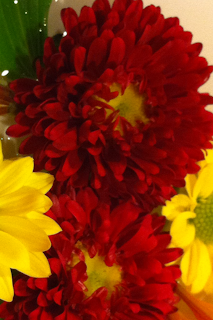Thank You !
 Learn and Practice
Learn and Practice
Wherever we are, math and science surround us. Last night at the Rotary dinner, the table setting of beautiful daisies and
So, as we try to bring science and math together, we can look around us in classrooms and the school yard. One of my groups today discussed using student surveys of shoe sizes, heights, favorites of some kind by grade/gender, etc. Getting kids interested in data by using data based on things that interest them or things in their world is easier than changing schedules. However, the activities this week have shown such value for students that this group of teachers has created ways to collaborate, to find ways to gather data in science and analyze it in math. Since the science takes longer, for instance, my science colleague will take two days for field labs (we even have already established a stream base nearby). She will only take half her class with her each day, and I will take the other students during writing class for their science time for that day. Those students can do prep work or set up the display website with background information while my other writing students continue their work. Nothing is impossible. As one of the participants today said, "Nothing in life is a straight line." So schedules, those linear Type A artifacts, need to be wrinkled to enable student learning.

And what will we learn? I think Fathom works in more than just math and science. Look at what it can do--
I learned to add summaries, models, and text to the Fathom exploration so that many aspects of data can be analyzed to understand exactly what those numbers are saying -- or not saying.
Isn't that amazing?
In another chart, I learned to hold the shift key down to highlight more than one data point; we discovered a relationship with our data points, even though the overall data didn't show any correlation. Because we weren't careful as a whole class (we were exploring) to conduct investigations in exactly the same way, but because our own data points were conducted the same way, we thought that did show some evidence that our own data had some relevance. Great conversations -- which led to my colleague and I to decide that students really do need to play around first, so they can discover the need to standardize the process of gathering the data so that the class data can mean something. Otherwise, some data may just stand out too much.
Finally, I meant to add to the excellent conversation during Mark's presentation. It's important to remember that students today really demand choice, so they will begin to play, display, and replay their discoveries and data immediately. It's important to allow them to choose their venue for display (like the Prezi team), and to choose options for their audience; it can't just be for the teacher. They can create YouTube, School Tube, or Vimeo videos, Voice Thread, Glogsters, Google Sites, etc. But who for? Will their work be shared with another school? another grade? parents? university scientists and mathematicians? That will help them focus their choices in images, verbiage, data analysis, graphs, etc. TAP: topic, audience, purpose.

And with that --- think of how we created our VoiceThreads. I walked around, took a break, and came back to draw a simple story board of a possible sequence for my colleague. We added a simple revision, then started. While creating it, we continuously revised. In other words -- no great
plan, just do. "Do or do not... there is no try," Yoda reminds us. Digital writing is fluid and natural, less pre-planning, but more natural revision -- and much more collaboration and sharing with each other (which means deeper learning !).
Question
Who knows how many talented people share their expertise for professional development? Some one needs to know that in our little corner of the world, talented people help teachers become better teachers. I've been teaching for over twenty-five years, and have attended many professional development "institutes." My favorite experience at Semiahmoo with the Bill and Milinda Gates Foundation treated teachers with deep respect and provided fantastic leaders to teach us. I must say though, this group of leaders for the
Math Science Partnership (rural schools) and
TMTW are extra-ordinairre! You have prepared so much relevant material, activities, lessons, and reflections. You have modeled process, content, pedagogy, and reflection. You respect the needs of your learners. You have engaged us to form a community of teachers who are reflective and always stretching to the edge of the best for student learning. You give honor to the teaching profession. Each of you truly represents the best of teaching.
Thank you for teaching us.
Photo Credits:
Others: Sheri Edwards
Sheri Edwards
Reflect curiosity and wonder...
Go boldly and scatter seeds of kindness..
42

















